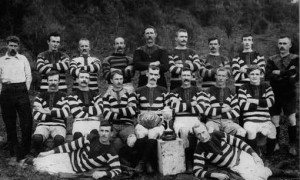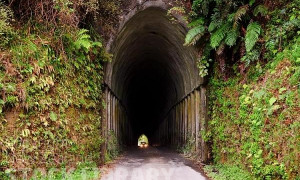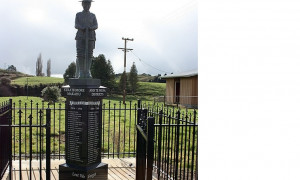History
Strathmore was named by one of the area’s first Pakeha settlers F.J. Stewart after a Scottish valley.
(An extract from an early newspaper)
From the saddle on to Strathmore, 21 miles out from Stratford, the road runs through Mr Stewart’s property, and follows the valley of the Mangatuki river, a branch of the Patea. Strathmore is undoubtedly a township with a future before it. It is sufficiently far away from Stratford to avoid clashing in any way, and is the natural centre of a great district; three important side roads have a junction there or near to, and the site for a town is all that can be desired. It is private property; the Government township is a little further on, almost adjoining, Mangaere by name. At present Strathmore boasts of a store and butchers business, run by Messrs Biernacki and Sells, a boarding house, a blacksmith’s shop, a post office and telephone communication with Stratford, and a town hall good enough for a town of a thousand inhabitants, and branch stables belonging to Messrs Hewer and Thacker, the mail contractors, and the coaching firm of the Ohura road and livery stable keepers of Stratford.
Mr B.E Philipps was the pioneer of Strathmore; towards the end of 1893 he bought sections in the township, put up a store and boarding house, and to him is due the erection of the town hall.
Statistics
Strathmore is a settlement in inland Taranaki. It is located on State Highway 43, 25 kilometres east of Stratford. A side road from Strathmore leads to Mākāhu and then to the farm settlement of Aotuhia. The Matemateaonga walkway to the Whanganui River begins at the Kōhī Saddle near Mākāhu.
Population
Approximately 100 people live in the Strathmore area.
Weather
Average temperature 14°C
Average rainfall 1592mm
Huiakama School
http://huiakama.school.nz/Huiakama School is a year 1 to 8 State primary school with a decile rating of 6 and a current roll of 15

Dean Cup
History
The Dean Cup was originally donated to the community by Mrs Athalinda Dean in 1906, to be played for in an annual cricket match between Whangamomona and Whangamomona Road.
However, it was found that the field was so rough it was suitable only for rugby, so in 1907 the cup became a rugby trophy.
The first rugby game was played between Strathmore and Whangamomona in 1907, with Strathmore coming out winners.
Many years ago, the cup was played for by four teams - Whanga, Strathmore, Toko and Ohura.
In 1914, Ohura pulled out of the contest and since then the three remaining teams have battled every year except the years of the First and Second World Wars and the Depression of the late 1920s.
The Dean Cup is made of solid silver and originally the first try scorer in a game drank from the cup (over a litre of beer).
However, over time, the cup was damaged and repairs were made to it in the 1960s, then it was placed in a transparent case. The cup is currently on display at the Toko Tavern.
Today, the first try scorer drinks from a yard glass.
There are rules surrounding the Dean Cup fixtures and these have remained mostly unchanged. The main rule is eligibility. There are basically three ways you can play for a team and they are: work in the district for at least three weeks, play for the rugby club in the district, or be from the district or have some sort of familyconnection.
Toko has won the cup 30 times, Strathmore 29 and Whanga 12. Although Ohura only played for a few years, they managed to win the cup seven times. All three Eastern District teams have produced top Taranaki players as well as the occasional New Zealand representative and All Black. They are: Mark Allen, Bob Scott, W H Abbott, J K Sullivan, Ray Sandford, Warwick Curtis, Con Coulton, Richie Coles, Alan Jury and Alan Smith.
The Dean Cup is the oldest rugby 'cup' still being competed for and the third oldest rugby trophy in New Zealand.

Makahu Tunnel
Makahu, named after the white hawk, was settled in 1896.
The first road to Makahu, heading east from Stratford towards Strathmore, climbed over a huge hill.
Nothing more than a pack track, it was widened in 1902 to become a dray road and the Mangaehu River bridged.
When the Makahu Co-operative Dairy Factory began producing butter a few years later, it was time to make the access even better to carry the produce out.
In 1907, using pick, shovel and explosives, the Makahu Tunnel was opened.
Though people protested that it was too near the top of the hill to be worthwhile, most were pleased as the new chain-long cut (20m) shortened the road by more than 3km.
The tunnel was supported by an interesting construction of wood and lined with timber, which eventually rotted at the Makahu end and collapsed in 1919.
It was then lined with a more robust material – concrete - in the form of pillars

War Memorial
War memorial at Brewer Road, Strathmore in east Taranaki.
The memorial records those from the surrounding districts who served in both First and Second World Wars. The memorial was unveiled on 8 Nov 2008. It was erected on the site of the Strathmore War Memorial Hall, demolished in 2006. The bronze plaque from the hall is attached to the fence alongside the memorial. The rolls of honour from the hall are in the Stratford RSA.
The memorial consists of a granite soldier figure on black marble plinth. It was designed by Daryl Anderson, Anderson's Monumentalists, Hawera. The soldier was sculpted by carvers in Xiamen, China